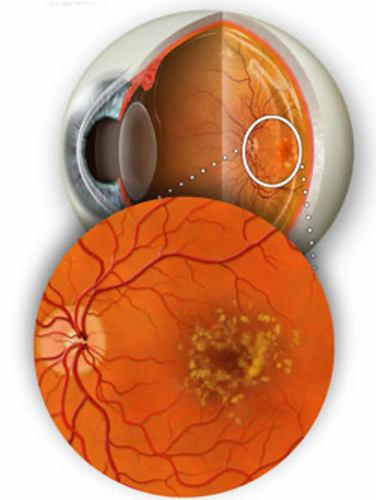
MACULAR DEGENERATION CARE
- EXAM & EVALUATION
- EYE TESTINGS
- EYE NUTRITION
- PATIENT COUNSEL & EDUCATION
EXAM: MACULAR DEGENERATION
Are You Over 50 ?
Macular Degeneration is the leading cause of vision loss, affecting more than 10 million Americans – more than cataracts and glaucoma combined.
At present, Macular Degeneration is considered an incurable eye disease.
Macular Degeneration is caused by the deterioration of the central portion of the retina, the inside back layer of the eye that records the images we see and sends them via the optic nerve from the eye to the brain. The retina’s central portion, known as the macula, is responsible for focusing central vision in the eye, and it controls our ability to read, drive a car, recognize faces or colors, and see objects in fine detail.
What is Age-related Macular Degeneration?
The human retina is made up of layers of cells that line the entire inside of the globe of the eye. The macula is the most sensitive part of the retina, located in the center. The macula is about the size of the head of a straight pin, and contains millions of light-sensing cells that provide sharp, detailed, “straight-ahead” central vision. When light strikes the back of the eye, the cells of the macula and the rest of the retina send electrical signals to the brain through the optic nerve. The brain translates the electrical signals into the images we see. When macula cells are damaged or destroyed, the images received by the brain are distorted.
- Age-related macular degeneration (AMD) is a progressive eye condition affecting as many as 15 million Americans and millions more around the world. There is no cure for AMD which destroys the clear central vision necessary for reading, driving, identifying faces, watching television, safely navigating stairs and performing other daily tasks we take for granted. It can make it more difficult to see contrast and can change the way color is seen. Peripheral vision may not be affected, and it is possible to see “out of the corner of your eye”.
- AMD is the number one cause of severe vision loss and legal blindness in adults over 60 in the U.S. It escalates with age. More than one senior in three over the age of 75 is likely to develop signs of AMD, with over 200,000 new cases diagnosed every year.
- There are two types of AMD – atrophic or “dry AMD” and neovascular or “wet AMD”. All AMD starts in the dry form. There are treatments available for wet AMD to stop disease progression, and research is underway to find an effective treatment to limit the vision loss that occurs with dry AMD. Even with vision loss resulting from AMD, training and special devices can promote independence and a return to favorite activities.
How did I get AMD?
There are some things you can do to reduce the risk of AMD. Research with large populations around the world has revealed a list of lifestyle factors that can be changed. Other things that contribute to AMD include your family history and age. While you can’t control these risk factors, it’s important to know about them.
Things You Can’t Change
- Age – AMD signs are present in about 14% of people 55–64; 20% of those age 65–75; and up to 40% of individuals over age 75.
- Gender – AMD is more common in women than in men.
- Race – AMD is more common in Caucasians than other races, but it exists in every ethnicity.
- Eye Color – AMD is more common in people with blue eyes.
- AMD in One Eye – If you have AMD in one eye, your chance of developing it in the other eye is higher. Dry AMD in one eye may predispose you to wet AMD in the other eye.
- Genetics – If others in your family have AMD, you have a greater risk of developing it.
Risk Factors You Can Change
- Smoking – Smoking increases your risk, especially if AMD runs in your family.
- Diet – A poor diet, low in antioxidants and high in saturated fats and processed foods may increase your risk of developing AMD.
- Obesity – People who are very overweight have a higher risk of AMD.
- Exercise – A sedentary lifestyle contributes to AMD.
- Cholesterol – High cholesterol is bad for your eyes and your heart.
- Blood Pressure – High blood pressure may be involved in AMD.
- Sun Exposure – Ultraviolet and blue light from the sun and electronics can damage the retina.
Eye Vitamin to Prevent AMD?
YES! With MacuHealth
- Available at Nova Eyecare Center! We always offer a 10% discount off Retail pricing for our patients!
- Restores Macular Pigment Exposure to high energy blue light increases oxidative stress on the retina, which over time can lead to Age Related Macular Degeneration (AMD). MacuHealth helps nature restore macular pigment to optimum levels, and may protect against AMD because of the anti-inflammatory and antioxidant nature of the three nutrients.
- Improves Visual Performance Visible blue light has a negative effect on the quality of the optical image formed at the retina. In fact, shorter blue light wavelengths scatter more than other wavelengths, thereby resulting in Glare, Chromatic Aberration, and Light Scatter. Consequently, these conditions contribute to loss of visual acuity. Macular pigment selectively filters out damaging and image-degrading visible blue light.
- Critical Carotenoids MacuHealth with LMZ3 is the only dietary supplement containing all three (3) critical nutrients, Lutein, Meso-Zeaxanthin and Zeaxanthin in the same 10:10:2 ratio that makes up macular pigment. Taken once a day, this small, easy-to-swallow soft gel is clinically proven to restore macular pigments to normal levels, resulting in enhanced vision and aid in the prevention of age-related macular degeneration.
Opening Hours
| Monday – Thursday | 8:30 – 5:00 |
| Friday | 8:30 - 4:00 |
| Saturday-Sunday | Closed |
| Open During Lunch |
